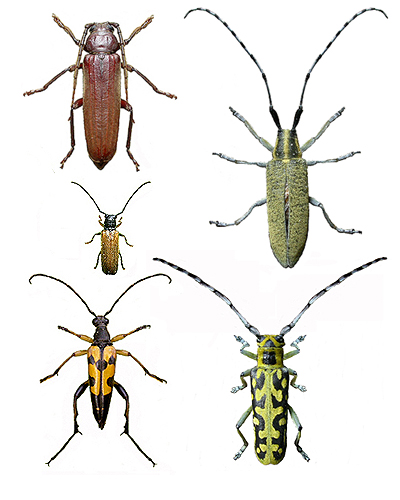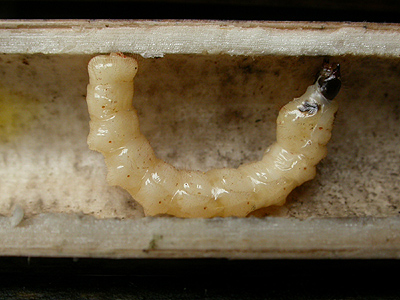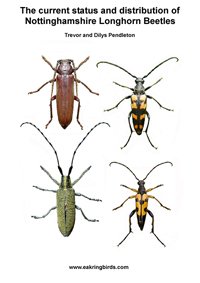

| Longhorn Beetles in Nottinghamshire |
| Among some of the
most impressive Nottinghamshire beetles, are longhorn
beetles. Longhorn
beetles belong to the family Cerambycidae. There
are currently 67 UK species, including some accidental
imports. Several species are common and easily noticed due to their bright colouration. Most species can be distinguished by their conspicuously long antennae which gives rise to the longhorn name. They are typically long bodied and long legged beetles. They also show a large size range and most are active by day, when the adults generally feed on nectar and often visit the flowers of Hawthorn, Dogwood and Umbellifers along woodland rides. Longhorn larvae feed within the timber of woody plants (including that which is dead or decaying) and several species are considered pests of coniferous plantations. Larvae are also sometimes imported from abroad within loads of timber. Scarce Cerambycidae in Nottinghamshire In the Sherwood Forest area, longhorn beetles are regularly encountered during the Summer months. Leptura quadrifasciata, Rutpela maculata and Clytus arietis are perhaps the most regularly recorded species. The real 'jewel in the crown' has to be Saperda scalaris. It is a rare species both locally and nationally and currently holds Nationally Scarce Grade A status, meaning it has only been recorded from 16-30 10km squares since 1980. Saperda scalaris is a visually stunning beetle, but many of our longhorns are attractively marked. |
 |
|
| ..... | ||
| The following list of scarce Cerambycidae have been recorded from the county, but Nottinghamshire has plenty of potential for adding new longhorns to the county species list. | ||
| ..... | ||
 |
Acanthocinus
aedilis Nb, Anaglyptus mysticus Nb, Aromia
moschata Nb, Gracilia minuta pRDB2, Grammoptera
abdominalis Na, Paracorymbia fulva RDB3, Poecilium alni Nb, Phytoecia
cylindrica Nb, Prionus coriarius Na, Saperda
carcharias Na, Saperda scalaris Na, Stenostola
dubia Nb and Stictoplura scutellata Na. Source:- Nottinghamshire Local Biodiversity Action Plan - Appendix A: List of species of conservation concern in Nottinghamshire. S.Wright. Left:- Full grown larva of Agapanthia villosoviridescens found at the base of a hollow stem of Hogweed at Sherwood Forest CP in December 2010. It was subsequently bred through for identification purposes and emerged in late January 2011. The Cerambycidae contain some of our largest beetles, with the Musk Beetle (Aromia moschata) being our largest by far. It's size really is impressive when first seen and the only other longhorn to come close in the size race, is largely nocturnal in it's habits. |
|
| ..... | ||
| Arhopalus
rusticus is a chestnut brown longhorn, but more
impressive in its size rather than colouration. The only
easy way to see this beetle, is by luring them in with an
MV light, but it seems a widespread species in
Nottinghamshire, especially in woodland dominated by
Pine. Identification and when to see them Correct identification of most species is relatively straight-forward, although, as with all insects, some degree of care has to be taken, pretty much all the species likely to be found in Nottinghamshire can be easily identified from photographs. Longhorn beetles are beetles of the Spring and Summer months and are often to be seen visiting flowers, but searching log piles in sunny situations is another productive method. There are now a total of 26 species illustrated. Several of these seem to be common and can be found in or around most Nottinghamshire woodlands. There are a few though, which have only found within the Sherwood Forest area and there are several more species which we have yet to come across and photograph. Grateful thanks go to Nick and Samantha Brownley for providing the photograph of Pogonocherus fasciculatus. |
||
| A checklist of Nottinghamshire Cerambycidae |
| Species shown with a red asterisk, are only known from historical records only |
| PRIONUS Geoffroy, 1762 |
| Prionus coriarius (Linnaeus, 1758) * |
| ..... |
| RHAGIUM Fabricius, 1775 |
| Rhagium inquisitor (Linnaeus, 1758) * |
| Rhagium bifasciatum (Fabricius, 1775) |
| Rhagium mordax (De Geer, 1775) |
| ..... |
| STENOCORUS Geoffroy, 1762 |
| Stenocorus meridianus (Linnaeus, 1758) |
| ..... |
| GRAMMOPTERA Audinet-Serville, 1835 |
| Grammoptera abdominalis (Stephens, 1831) * |
| Grammoptera ruficornis (Fabricius, 1781) |
| ..... |
| LEPTURA Linnaeus, 1758 |
| Leptura quadrifasciata (Linnaeus, 1758) |
| ..... |
| STICTOLEPTURA Casey, 1924 |
| Stictoleptura rubra (Linnaeus, 1758) |
| Stictoleptura scutellata (Fabricius, 1781) * |
| ..... |
| PARACORYMBIA Miroshnikov, 1998 |
| Paracorymbia fulva (De Geer, 1775) |
| ..... |
| ALOSTERNA Mulsant, 1863 |
| Alosterna tabacicolor (De Geer, 1775) * |
| ..... |
| PSEUDOVADONIA Lobanov, Danilevsky & Murzin, 1981 |
| Pseudovadonia livida (Fabricius, 1777) |
| ..... |
| RUTPELA Nakane & Ohbayashi, 1959 |
| Rutpela maculata (Poda, 1761) |
| ..... |
| STENURELLA Villiers, 1974 |
| Stenurella melanura (Linnaeus, 1758) |
| Stenurella nigra (Linnaeus, 1758) |
| ..... |
| ASEMUM Eschscholtz, 1830 |
| Asemum striatum (Linnaeus, 1758) |
| ..... |
| ARHOPALUS Audinet-Serville, 1834 |
| Arhopalus rusticus (Linnaeus, 1758) |
| ..... |
| GRACILIA Audinet-Serville, 1834 |
| Gracilia minuta (Fabricius, 1781) * |
| ..... |
| MOLORCHUS Fabricius, 1793 |
| Molorchus minor (Linnaeus, 1758) |
| ..... |
| AROMIA Audinet-Serville, 1833 |
| Aromia moschata (Linnaeus, 1758) |
| ..... |
| HYLOTRUPES Audinet-Serville, 1834 |
| Hylotrupes bajulus (Linnaeus 1758) |
| ..... |
| CALLIDIUM Fabricius, 1775 |
| Callidium violaceum (Linnaeus, 1758) * |
| ..... |
| PYRRHIDIUM Fairmaire, 1864 |
| Pyrrhidium sanguineum (Linnaeus, 1758) |
| ..... |
| PHYMATODES Mulsant, 1839 |
| Phymatodes testaceus (Linnaeus, 1758) |
| ..... |
| POECILIUM Fairmaire, 1864 |
| Poecilium alni (Linnaeus, 1767) |
| ..... |
| CLYTUS Laicharting, 1784 |
| Clytus arietis (Linnaeus, 1758) |
| ..... |
| PLAGIONOTUS Mulsant, 1842 |
| Plagionotus arcuatus (Linnaeus, 1758) * |
| ..... |
| ANAGLYPTUS Mulsant, 1839 |
| Anaglyptus mysticus (Linnaeus, 1758) |
| ..... |
| AGAPANTHIA Audinet-Serville, 1835 |
| Agapanthia villosoviridescens (De Geer, 1775) |
| ..... |
| POGONOCHERUS Dejean, 1821 |
| Pogonocherus fasciculatus (De Geer, 1775) |
| Pogonocherus hispidulus (Piller & Mitterpacher, 1783) * |
| Pogonocherus hispidus (Linnaeus, 1758) |
| ..... |
| ACANTHOCINUS Dejean, 1821 |
| Acanthocinus aedilis (Linnaeus, 1758) * |
| ..... |
| LEIOPUS Audinet-Serville, 1835 |
| Leiopus nebulosus (Linnaeus, 1758) |
| ..... |
| SAPERDA Fabricius, 1775 |
| Saperda carcharias (Linnaeus, 1758) * |
| Saperda populnea (Linnaeus, 1758) * |
| Saperda scalaris (Linnaeus, 1758) |
| ..... |
| STENOSTOLA Dejean, 1835 |
| Stenostola dubia (Laicharting, 1784) |
| ..... |
| PHYTOECIA Dejean, 1835 |
| Phytoecia cylindrica (Linnaeus, 1758) |
| ..... |
| TETROPS Stephens, 1829 |
| Tetrops praeustus (Linnaeus, 1758) |
| Known introductions/accidentals |
| ..... |
| MONOCHAMUS Megerle in Dejean, 1821 |
| Monochamus sartor (Fabricius 1787) * |
| Monochamus sutor (Linnaeus, 1758) * |
| References: |
| A.G. Duff. Checklist of Beetles of the British Isles, 2008 edition. |
| The current status and distribution of Nottinghamshire Longhorn Beetles (pdf version) | ||||
| ..... | ||||
 |
The Cerambycidae
represent some of Nottinghamshire's most impressive
beetles. Commonly known as Longhorn Beetles, there are nearly 70 known
UK species, including some accidental imports. This now out of date pdf version of the Atlas, produces up to date distribution maps of all the Longhorn beetles recorded in the county over recent years, but does list all the species we can trace as having been recorded in the county. Published January 2015 |
|||